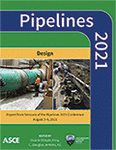It’s All True—Solid, Liquid, and Gas Don’t Mix in Inverted Siphons!
Publication: Pipelines 2021
ABSTRACT
This paper explores the performance parameters of inverted siphons (also known as depressed sewers) in sewerage and raw water conveyance systems. It focuses on the management of water, air, and sediment transport in two design case studies in the Pacific Northwest. The paper discusses the mechanisms of air/gas and sediment development in conveyance systems, literature review findings, lessons learned from historical installations, the design steps adopted in the case studies, and what can be done to minimize the risks of air and sediment capacity restrictions. A focused understanding of sediment characteristics, mechanisms for development, and how air and sediment behave at critical flow rates will assist in maintaining conveyance capacity through profile development and infrastructure placement and geometry. The design solution for air and sediment transport need to consider the transport impact on both. It is economically impractical to eliminate particle and air retention in inverted siphons, but through appropriate design processes, their behaviors can be better understood and impacts reduced.
Get full access to this article
View all available purchase options and get full access to this chapter.
REFERENCES
A.R.I. and NETAFIM. (No date). “Critical velocity required for transporting air bubbles.” Air Valves and Check Valves Catalogue. p. 5.
ASCE. (2007). Gravity Sanitary Sewer – Design & Construction. Second edition. Table 5-3.
AWWA (American Water Works Association). (2016). Air Valves: Air-Release, Air/Vacuum & Combination. Manual of Water Supply Practices M51, Second edition.
Escaramela, M., Dabrowski, C., Gahan, C., and Lauchlan, C. (2005). Experimental and Numerical Studies on Movement of Air in Water Pipelines. HR Wallingford Limited., April.
Herrick, P. (2012). Grit Happens – You Don’t Know What You Are Missing. Hydro International - Wastewater Division, 2925 NW Aloclek Drive, #140, Hillsboro, OR 97124.
May, R. W. P. (2000). Preventing Sediment Deposition in Inverted Sewer Siphons.
United States Department of Commerce. (1981). Prediction of the Hydraulic Jump Location following a Change of Slope in a Partially Filled Drainage Pipe. U.S. Department of Commerce National Bureau of Standards Centre for Building Technology, Washington, DC 20234. May.
United States Department of the Interior, Bureau of Reclamation. (1978). Design of Small Canal Structures. https://www.usbr.gov/tsc/techreferences/mands/mands-pdfs/SmallCanals.pdf. Denver, Colorado.
United States Department of the Interior, Water and Power Resources Service. (1980). Air-Water Flow in Hydraulic Structures. December.
Walski, T. M., Barnhart, T. S., Driscoll, J. M., and Yencha, R. M. (1994). “Hydraulics of corrosive gas pockets in force mains.” Water Environment Research. Vol. 66, No. 6.
Wu, J., and He, C. (2010). “Experimental and modeling investigation of sewage solids sedimentation based on particle size distribution and fractal dimension.” Int. J. Environ. Sci. Technol. 7, 37–46.
Information & Authors
Information
Published In
Copyright
© 2021 American Society of Civil Engineers.
History
Published online: Jul 29, 2021
Authors
Metrics & Citations
Metrics
Citations
Download citation
If you have the appropriate software installed, you can download article citation data to the citation manager of your choice. Simply select your manager software from the list below and click Download.
